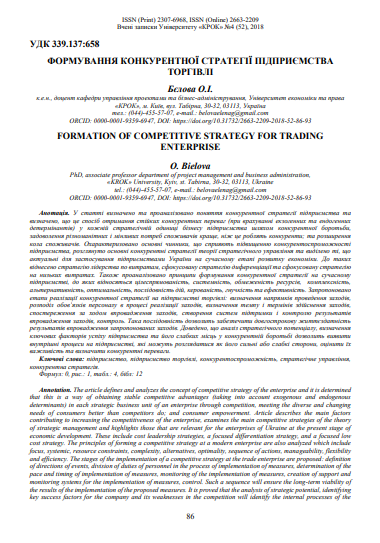FORMATION OF COMPETITIVE STRATEGY FOR TRADING ENTERPRISE
DOI:
https://doi.org/10.31732/2663-2209-2018-52-86-93Keywords:
enterprise, trade enterprise, competitiveness, strategic management, competitive strategyAbstract
The article defines and analyzes the concept of competitive strategy of the enterprise and it is determined that this is a way of obtaining stable competitive advantages (taking into account exogenous and endogenous determinants) in each strategic business unit of an enterprise through competition, meeting the diverse and changing needs of consumers better than competitors do; and consumer empowerment. Article describes the main factors contributing to increasing the competitiveness of the enterprise, examines the main competitive strategies of the theory of strategic management and highlights those that are relevant for the enterprises of Ukraine at the present stage of economic development. These include cost leadership strategies, a focused differentiation strategy, and a focused low cost strategy. The principles of forming a competitive strategy at a modern enterprise are also analyzed which include focus, systemic, resource constraints, complexity, alternatives, optimality, sequence of actions, manageability, flexibility and efficiency. The stages of the implementation of a competitive strategy at the trade enterprise are proposed: definition of directions of events, division of duties of personnel in the process of implementation of measures, determination of the pace and timing of implementation of measures, monitoring of the implementation of measures, creation of support and monitoring systems for the implementation of measures, control. Such a sequence will ensure the long-term viability of the results of the implementation of the proposed measures. It is proved that the analysis of strategic potential, identifying key success factors for the company and its weaknesses in the competition will identify the internal processes of the company, which can be viewed as strengths or its weaknesses, assess their significance and determine competitive advantage.
Downloads
References
Балабанова Л. В. Маркетингове управління конкурентоспроможністю підприємств: стратегічний підхід: монографія. Донецьк, 2006. 294 с.
Батенко Л. Практические подходы к повышению эффективности организации производственных процессов. Менеджер по персоналу : журнал. 2009. № 7. С. 59-67.
Бєлова О. І. Теоретичні аспекти формування мотиваційного механізму стратегічного управління торговельними мережами. Інноваційна економіка : журнал. №10, 2012, С. 109-115.
Бєлова О. І. Методологічний підхід до формування змісту та структури мотиваційного механізму стратегічного управління торговельними мережами. БІЗНЕС-ІНФОРМ : журнал. БИ-2-2013, С. 155-163.
Бєлова О. І. Формування тривимірної матриці станів мотиваційного механізму стратегічного управління торговельними мережами, № 2, 2013, С. 52-57.
Гордієнко П. Л. Стратегічний аналіз : навч. посіб. Київ : Алерта, 2008. 478 с. 464-473.
Довгань Л. Є. Стратегічне управління : навч. посіб. 2-ге вид. Київ : ЦУЛ, 2011. 440 с.
Наливайко А.П. Теорія стратегії підприємства. Сучасний стан та напрямки розвитку: монографія. Київ : КНЕУ, 2001. 227 с.
Петрова І. Л. Стратегічне управління людськими ресурсами: навч. посіб. Київ : КНЕУ, 2013. 466 c.
Петрова І. Л. Інноваційна діяльність: стимули та перешкоди: монографія. Київ, 2010. 320 с.
Хміль Ф. Удосконалення управління вітчизняними організаціями в контексті економічних та суспільних змін. Вісник Тернопільського національного еконічного університету : журнал. 2009. №1. С. 31-35.
Шершньова З. Є. Стратегічне управління : підручник. 2-ге вид., перероб. і доп. Київ : КНЕУ, 2004. 699 с.


